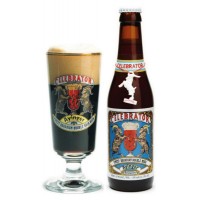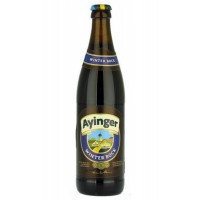Comprar Ayinger Celebrator - Schloss Eggenberg Samichlaus Classic - Ayinger Winter Bock
Ayinger Celebrator Doppelbock
A beer that has a dominant malty taste. This beer’s origins in a monk’s recipe are reflected in its heartiness. The Pope of Beers, Conrad Seidl, describes it as: “Almost black with a very slight red tone, a sensational, festive foam and truly extraordinary fragrance that at first summons up visions of greaves lard. The first taste is of mild fullness with an accompanying coffee tone, which becomes more dominant with the aftertaste. There is very little of the sweetness that is frequently to be tasted with doppelbock beer.” The Ayinger Celebrator has been ranked among the best beers of the world by the Chicago Testing Institute several times and has won numerous medals.
------------------------------------------------
Lager Doppelbock Bock Tostada. El color es caoba profundo con reflejos rojo rubí. Presenta espuma sólida. Aroma a nuez y un toque de cedro. Notas tostadas. Sabor mucho cuerpo. Tostado, afrutado a malta.
El Beerpope Conrad Seidl, la describe de la siguiente manera: "Casi negro, con tono ligeramente rojizo, una espuma sensacional, sólida y un olor muy raro, que recuerda a la primera manteca.
Celebrator Ayinger se ha clasificado en varias ocasiones por el Instituto de Pruebas de Chicago en el número de las mejores cervezas del mundo y ha ganado numerosas medallas.
Schloss Eggenberg Samichlaus Classic
Cerveza especial fuerte, austriaca, 14% de alcohol, de baja fermentación.
De color rojizo, aromas a Coñac, cuerpo firme, tiene toques de cereza y crema catalana, con un caluroso final a especias y pimienta.
Samichlaus es la cerveza de baja fermentación más fuerte del mundo. Aunque puede variar de un año a otro, siempre tiene como mínimo un 14% de alcohol; algún año llegó a tener casi el 15%. Una vez elaborada -el 6 de diciembre- y fermentada por primera vez, pasa por una lenta segunda fermentación en tanque a baja temperatura (lagering) que dura un año. De vez en cuando pasan la cerveza de un tanque a otro para reavivar la segunda fermentación.
Después de embotellada aún puede envejecer durante años en la botella.
Conseguir una cerveza de 14% a base de fermentación es casi imposible, porque la levadura que trabaja en los mostos de cerveza suele morir al alcanzarse un porcentaje de alcohol del 11-12%. El cervecero de Hürlimann se dedicó durante años a seleccionar sus levaduras para que fueran capaces de resistir estas condiciones especiales, consiguiendo de este modo esta cerveza tan potente.
La Samichlaus no es una cerveza normal, por lo que resulta muy difícil combinarla con comida. Se considera más como un brandy, de postre como copa y con chocolate negro!
Ayinger Winter Bock
The recipe for this beer goes right back to monastery traditions. The complex triple mash process using four types of malt gives the dark “doppelbock” its characteristic malty dominance and its close to black color. The storage time of 16 weeks produces a pronounced, well-rounded taste. Despite a high original wort content, the sweetness that is frequently present with doppelbocks can scarcely be detected. The first taste is of mild fullness with an accompanying coffee tone, which becomes more dominant with the aftertaste. Between November and January you can allow yourself to be completely won over by the excellent quality of the Winter Bock.
- Amai Gold - Tempus Dorada - La Gitanilla Cordobesa
- BBC Monserrate Roja - Apóstol Dubbel - Apóstol Weizen
- Amstel Oro - Miller Genuine Draft
- Estrella Galicia 1906 Red Vintage - Maisel & Friends Bavarian Ale - Staropramen Premium Lager
- Barret Caubeen - Edge Brewing White Liar - Guineu NZ IPA
- Cierva Blond Ale - Familia Serra Butoni - Seef Bier
- Te Deum Bruin - St Feuillien Cuvée de Noël - Boon Kriek Mariage Parfait
- Estrella Galicia 1906 Red Vintage - Mahou Cinco Estrellas - Ambar 1900
- Mikkeller Henry Jagger - Mikkeller Spontanale - Mikkeller Vesterbro Brown
- Mahou Clásica - Alhambra Especial - Asahi Super Dry
- La Puntaire d`Arenys - Naparbier Hop Doom - La Negra de las Doce Vermella
- De Molen Dag & Dauw - La Trappe Witte Trappist - De Molen / Omnipollo Sitis
- Illice Augusta Aurum - Tormo Irish Red Ale - Maeloc Sidra Extra Ecológica
- Emelisse D.I.P.A. - Emelisse Urtype Pilsener - Emelisse Porter
- Birra del Borgo My Antonia - La Piñonera Strong Ale - Tübinger Tübinator
- Dougall’s Session Stout - Dougall’s IPA 8 - Redneck Brandine
- Caleya Asturies Pale Ale - Judas
- Bizarra Weissbier - Ambar Caesaraugusta - Cazurra Burton Ale
- Tarraco IPA - Ratpenat 2014 IPA - Barbarian 174 IPA
- Montmirà Bresca - St. Louis Premium Kriek - Mort Subite Xtreme Kriek
- Acacia Burdeos - De Glazen Toren Ondineke Tripel - Silly Enghien Noël Triple Blonde
- Tübinger Hoppiness IPA - Tübinger Tübinator - Flannery’s Irish Cream Stout
- Heineken - Sagres
- San Miguel Especial - Alhambra Especial
- Corona Extra - Tecate - Indio
- R115 Evil Wedding - BIIR / Brewerkz Hoppy Monk - Hazteunlitro The Fucker In The Rye
- Cantillon Iris - Dubuisson Cuvée des Trolls Triple
- Modelo Especial - Tecate
- Mezquita - Voll-Damm - Alhambra Tradicional
- One Road - Birra 08 11 Llúpols - Amager The Bastard Princess
- Alhambra Especial - San Miguel 1516 - San Miguel Magna
- Victoria - Grupo Modelo - Tecate - Indio
- Helheim Hidromiel - La Fragua Hidromiel Clásica - La Runa Hidromiel Dulce
- Volaera Especial - Debla IPA - Nómada Bokashi
- Morlaco APA - Exulans Pale Ale Nº3
- Mahou Cinco Estrellas - Cruz Campero
- San Miguel Magna - San Miguel Selecta - Grimbergen Blonde
- Bel Pils - Tripel Karmeliet - Chimay Première (Red)
- Corona Extra - Estrella Galicia 0,0
- Affligem Dubbel - Lagunitas Little Sumpin’ Sumpin’ Ale
- Brugse Zot - Struise Black Damnation - Kasteel Rouge
- Pater Lieven Blond - Chimay Grande Réserve (Blue)
- Budweiser - Ambar Triple Zero
- Quilmes Stout - Quilmes Bock - Quilmes Red Lager
- Pacífico Light - Corona Light - Estrella
- Ambar Export - Alhambra Reserva 1925 - San Miguel Especial
- Urthel Saissoniere - Cantillon Iris
- Weihenstephaner Hefeweissbier - Marbi Weissbier - Homero Hefeweizen
- Founders All Day IPA - Flying Dog Double Dog - Guinness Nitro IPA
- Corona Extra - Tecate - Noche Buena
- El Águila Sin Filtrar - Voll-Damm - Bock Damm
- Paulaner Hefe-Weißbier / Hefe-Weizen / Weissbier - Estrella Galicia 1906 Reserva Especial - La Milnueve
- Alvinne / Laugar Ich bin ein Berliner Ryesse - Laugar Anniversary 2016 - Laugar LSB 2017 Lisergic Strong Beer
- 3Monos Golden Ape - Maier Lola
- La Cibeles IPA Dry Hopping - Des Pla Xeixa - Baias Green Go
- Oud Beersel Oude Geuze (Vieille) - Boon Oude Geuze
- Victoria - Grupo Modelo - Corona Extra
- Los Bichos Mandan Kriek - Abbaye de Saint Bon-Chien - Vander Ghinste Roodbruin
- Fábrica Maravillas Flipa - El Cuervo - Yria Bearliner Weisse
- Fort India Pale Ale - Fort Christmas Belgian Blond - Fort Apricot Cream





















